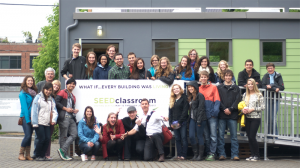
The wait has been long and the hurdles high, but Jasper’s students haven’t given up hope of one day planting a sustainable, living classroom in town.
In fact, the Jasper Sustainability Club for Youth, along with the help of parents and teachers, has set itself a goal: by September the students hope to have all of the pieces in place to bring a SEED (Sustainable Education Every Day) classroom to Jasper.
That was the message Christopher Read presented to public officials, parents, teachers and donors when the club gave the community an update on the project, Jan. 13.
“We didn’t bring you here to say, yup there’s always hurdles and we haven’t been able to get over them yet,” said Read, who was acting as moderator for the evening. “That is a fact: there have been hurdles this whole time and we haven’t got over them yet. But what is different for all of us, and what we’ve been very clear about with this 2015 resolution, is that we are committed to having something in place that gets us ... much farther than we are today.
“Ideally we’d have everything wrapped up by September of 2015. That would mean funding; that would mean coordination with Parks; that would mean coordination with the town; that would mean partnering with any other organizations that we need to partner with.
“All of these alumni are here tonight because they believe in that plan,” he said, referring to students that joined the meeting via Skype.
In 2012, the sustainability club travelled to Portland for the Living Futures Conference, where they presented in front of sustainable designers, architects and builders, sharing their experience working with the provincial government on the design of the new Joint School Facility, which opened last year.
That experience quickly turned sour when few, if any, of their ideas for a sustainable school were considered.
After sharing their story at the conference, the students met Stacy Smedley, a sustainable architect from Seattle. Smedley was inspired by their story and wanted to help them achieve their goals of building a net-zero school.
That inspiration led to her to design the first SEED, a modular classroom that meets the stringent requirements of the Living Building Challenge, using only what it receives from the environment: rainwater and solar power.
Smedley hoped that through her own fundraising efforts she would be able to bring the prototype to Jasper. But, after running into difficulty raising the funds in Seattle, she was forced to sell it to another school in 2013 in order to cover her costs.
That sale happened after Jasper’s students had already raised $50,000 toward the $180,000 classroom.
Via Skype, Smedley said it makes her emotional that Jasper’s students continue to persevere, despite the challenges they’ve faced along the way.
“And I am also emotional because there’s not one there yet and I want to find a way to make that happen.”
To bring a SEED to Jasper, Smedley needs to sell 20 of the classrooms. That’s the number that will allow her to cover the cost of one SEED, excluding the cost of transport, permitting and building the structure once it’s here.
So far, three have sold.
The good news is that SEED classrooms are gaining traction in Canada. According to Smedley, Simon Fraser University recently received a provincial grant to purchase one and it will soon be featured on CBC Radio and Television.
As well as the media attention, Smedley has also attracted a Canadian manufacturer for SFU’s project and it is also interested in the Jasper SEED.
“I’m working through that conversation right now,” she said.
But in the meantime, Jasper’s students aren’t putting all of their eggs in one basket.
Rather than waiting for 20 classrooms to sell, they’re going to put their energy into grant applications.
“One of the things that the students brought up at our last planning meeting in December is that we should exhaust every other option,” said Read. “It isn’t just about sitting around waiting for the 20. That’s not what our goal is.”
Rather, the goal is to find the remaining $130,000 any way possible. Those efforts likely won’t include much more fundraising, though, as the club feels it has already exhausted the community.
“To try to ask more of this community didn’t sit well with us at this time,” said Read, “but if the community said, ‘actually we’ve got a bunch of money we were hiding,’ we would open the pockets, for sure.”
Although three years have passed since the sustainability club was promised a SEED, Jasper’s students are still positive the day will come when it arrives in town, and they’re willing to put in the effort.
“It’s been so long that we’ve been working on this and yet there are so many people who haven’t given up on it,” said Tannin Standing. “That’s why I came tonight: because I haven’t given up on it.
“It’s really inspiring to me because it’s something that we have done and it’s a step towards something. If the SEED classroom were to come to Jasper it would make me feel like youth is making a difference and is being heard, and I think that’s really important.”
The club plans to update the community again in September.
Nicole Veerman
[email protected]
